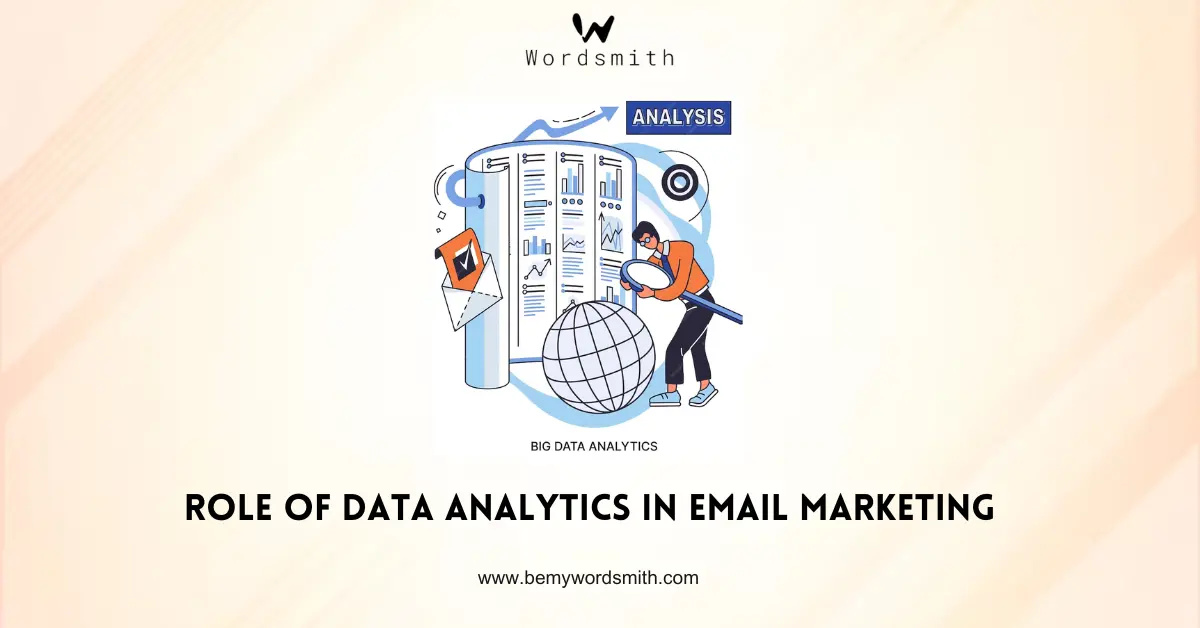Role of Data Analytics in Email Marketing
Jaishree D | 12-02-2024 | 04 min read

Analytics is the beat that directs the movement in the complex dance of email marketing, where each step and turn is intended to captivate the audience. Analyzing subscriber activity through analytics is more than simply looking at stats and graphs; it's also about figuring out what your audience wants and how they respond to the tunes of your emails. Analytics transforms information into understanding, understanding into a plan, and a plan into a relationship. An effective email marketing campaign depends heavily on analytics in the digital age since every click and every open can be monitored. It's the distinction between having a meaningful conversation and ranting into thin air.
A journey into the core of email analytics is provided by this article. We will peel down the layers of information to assist you understand subscriber behavior, from the fundamentals of grasping important indicators to the subtleties of predictive analysis. With this information at hand, you can create email campaigns that engage your audience and produce measurable outcomes by making them feel as much as they see.
Understanding the Metrics: The Basis of Analytics Using analytics in email marketing is like having a GPS in a big, digital communication wilderness. It guarantees that every campaign is headed in the proper direction and gets the subscriber's participation and activity. It also gives direction and clarity.
Key Performance Indicators:
It is necessary to comprehend what you are measuring and why before you can motivate action. For your campaigns, the most important measurements are called Key Performance Indicators, or KPIs. The number of people who are piqued enough by your subject line to open your email is shown by the open rate. The number of readers who were compelled to continue reading your content is indicated by the click-through rate. A step further, conversion rates display the proportion of readers who fulfilled a desired activity, like buying something or registering for an event.
The Importance of Access Rates
The first measure of success is open rates. They gauge how appealing your email is at first glance and are impacted by things like the sender name, subject line, and time of day. If your email opens frequently, it appears to have passed the initial test of drawing attention in a cluttered inbox.
Examining Click-Through Rates in Depth
Compared to open rates, click-through rates provide a more accurate indication of engagement. They show if the content of your email inspired a response in addition to whether it was opened. This metric assists you in determining how appealing your CTAs are and how successful your message is.
Conversion Rates
Most email marketing efforts have conversions as their ultimate objective. Conversion rates gauge the success of your email in eliciting a definitive action, such as finishing a purchase, enrolling in a webinar, or downloading an asset. This KPI shows how well your offers match subscriber wants and how relevant the content of your emails is.
Subscription insights and segmentation
The goal of segmentation is to cut up your large audience into digestible, manageable chunks. It's the practice of applying analytics to comprehend different subscriber groups, their preferences, and behaviors in order to create email campaigns that are more successful and precisely targeted.
Analytics's Power of Segmentation
Sending more individualized emails is made possible by segmentation. Analytics gives the information needed to build segments according to engagement levels, historical purchase history, demographics, and other factors. Analytics, for example, can identify subscribers who regularly read emails but do not click through, indicating that this group needs more enticing content or calls to action.
Recognizing Behavior for Customized Content
Analytics can show trends in the ways that certain segments respond to your emails. Do some themes provide more openings for a particular group? Do other people's click-through rates increase when an email includes a video? You may use this data to customize your content strategy so that emails are sent to each segment based on their unique interests and activities.
Using Information for Marketing Subscriber Lifecycles
Subscribers follow your brand on a journey, and you can use analytics to see where each subscriber is at in the lifecycle. Long-term subscribers may earn loyalty awards, while new subscribers may receive welcome emails. By sending the appropriate message at the correct moment, you can seamlessly guide subscribers from awareness to advocacy with the help of analytics.
Developing Targeted Advertising
In addition to providing a look back at previous campaigns, analytics gives you the insight to create future emails with accuracy. You may increase the relevance and impact of your messages by customizing them to certain segments based on subscriber behavior.
Producing Relevant Content
Analytics gives you information about the subjects and kinds of material that your audience responds to most well. Make content with a greater level of connection by using this data. You can create a campaign with tutorials, advice, and learning materials especially for a specific audience segment, for instance, if analytics reveal that their attention is drawn to educational content.
Time and Frequency Determined by Understanding
When it comes to when they want to receive emails, subscribers are not all created equal. While some people read better on the weekends, others could read better in the middle of the week. By identifying these tendencies with the aid of analytics, you can plan campaigns for the times when your subscribers are most likely to respond. In a similar vein, you can change how frequently of emails tailored to distinct segments in order to prevent either under- or over-engagement.
Comparative Evaluation Acquired through Analytics
Make use of data to guide your approach to A/B testing. To determine which iterations produce the best results, test various components, such as subject lines, email designs, and call to action with different segments.
Customization to Increase Involvement
Analytics allows you to personalize information based on engagement history, website behavior, and past purchases in addition to first-name personalization. Higher engagement rates result from each subscriber feeling seen and understood at this level of customisation. You may design a campaign that provides related goods or services to a given product category that makes regular purchases of that product.
Popular blogs

Online and Offline Tools Used by Interior Designer
High competence in these areas is required of interior designers. Even if you possess an innate sense of style ...

Human Resources Metrics and Analytics: Measuring Success for Organizational Effectiveness
Are you eager to take your HR strategy to the next level? Yes, then this article is for you. By utilizing HR an...

Mastering Macramé: Knots, Techniques, and FAQs
Since ancient times, macramé has gained popularity as a technique for creating textiles and other decorations t...
Submit a Comment